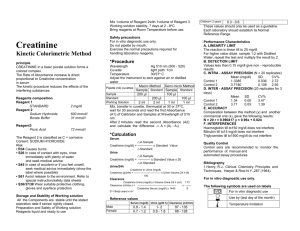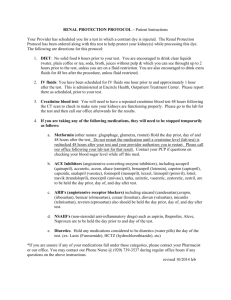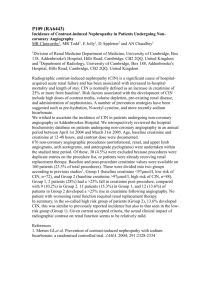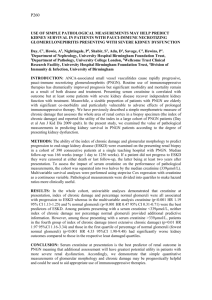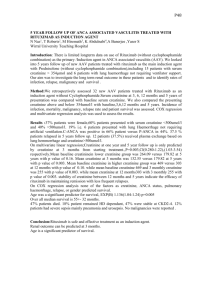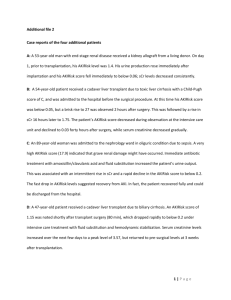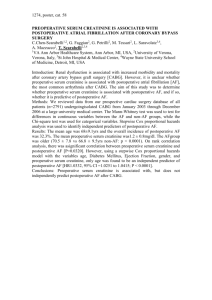Fenofibrate reversibly increases serum creatinine level in CKD
advertisement
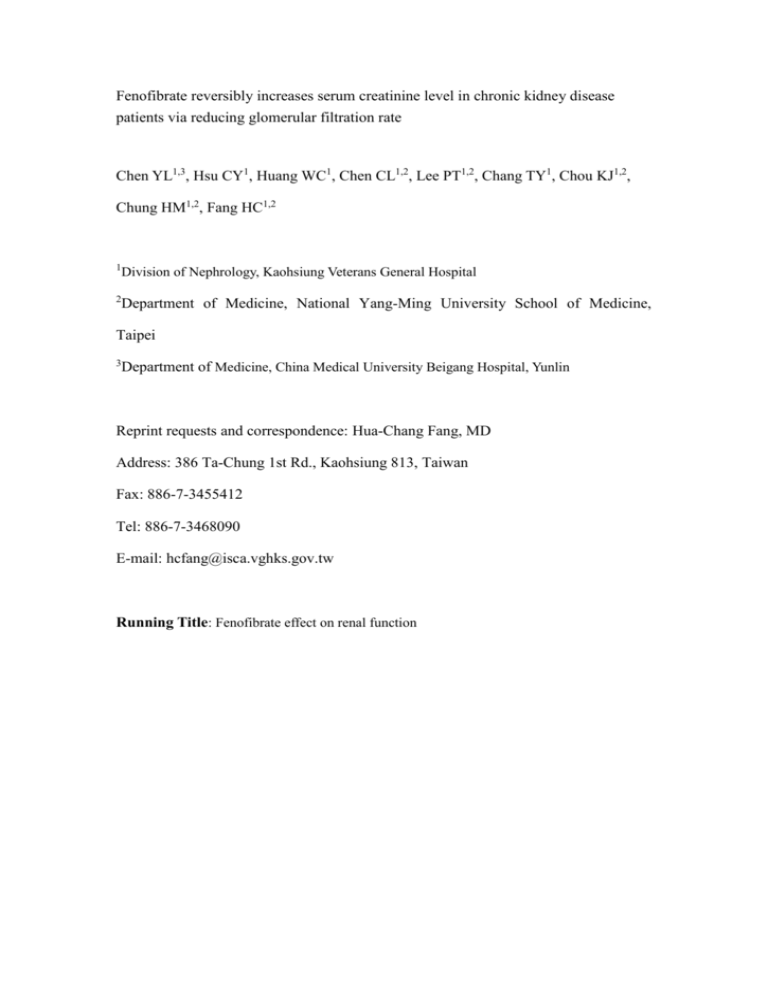
Fenofibrate reversibly increases serum creatinine level in chronic kidney disease patients via reducing glomerular filtration rate Chen YL1,3, Hsu CY1, Huang WC1, Chen CL1,2, Lee PT1,2, Chang TY1, Chou KJ1,2, Chung HM1,2, Fang HC1,2 1 Division of Nephrology, Kaohsiung Veterans General Hospital 2 Department of Medicine, National Yang-Ming University School of Medicine, Taipei 3 Department of Medicine, China Medical University Beigang Hospital, Yunlin Reprint requests and correspondence: Hua-Chang Fang, MD Address: 386 Ta-Chung 1st Rd., Kaohsiung 813, Taiwan Fax: 886-7-3455412 Tel: 886-7-3468090 E-mail: hcfang@isca.vghks.gov.tw Running Title: Fenofibrate effect on renal function Abstract: Background: Fenofibrate is a potent lipid-lowering agent that was found to increase serum creatinine and the underling mechanism remains controversial. Methods: Thirteen hypertriglyceridemic patients of 69±16 years old, 9 males and 4 females who presented an acute rise of serum creatinine 2 weeks to 6 months after starting fenofibrate (200 mg daily) treatment were recruited. Other possible causes of acute renal failure were excluded based on clinical judgment. Serum creatinine level, BUN, creatinine clearance calculated using a 24-h urine collection, and estimation of glomerular filtration rate using Cockroft-Gault formula were obtained on treatment of fenofibrate. The same tests were repeated 2 weeks after discontinuation of the treatment. Results: The data show that serum creatinine rose from 1.8 (1.3 – 4.9) mg/dL before the treatment to 3.0 (1.8 – 5.0) mg/dL (p < 0.05) and BUN from 27 (18 – 40) to. 38 (27 – 58) mg/dL (p < 0.05) 2 weeks to 6 months after the treatment. After discontinuing fenofibrate, serum creatinine declined from 3.0 (2.0 – 4.5) to 2.1 (1.7 – 4.1) mg/dL (p < 0.05), BUN from 34 (52 – 26) to 24 (19 – 39) mg/dL (p < 0.05), Cockroft-Gault estimated GFR increased from 32 (23 – 49) to 47 (31 – 65) mL/min (p < 0.05) and creatinine clearance increased from 37 (25 – 49) to 54 (39 – 67) mL/min (p < 0.05). However, daily urine creatinine excretion did not change significantly, from 18.1 (15.1 – 24.5) to 19.3 (13.2 – 22.7) mg/kg/day. Conclusion: Our study shows fenobibrate reversibly increased serum creatinine level with simultaneous BUN changes but no change of creatinine production. The results suggest a reduction of glomerular rate is responsible for elevation of serum creatinine. Keywords: fenofibrate; serum creatinine; glomerular filtration rate Introduction Lipid metabolism abnormality is common in chronic kidney disease (CKD) patients that are at greater risk for developing accelerated atherosclerosis and cardiovascular events [1,2]. Fenofibrate is a lipid-modifying agent that is mainly used to reduce low-density lipoprotein cholesterol and triglyceride levels, and to increase high-density lipoprotein cholesterol level [3]. Fibrates exerts its therapeutic effects through activation of peroxisome proliferator-activated receptor (PPAR), nuclear receptors. These nuclear receptors, once bound by fibrates, down-regulate the expression of the inducible COX-2 enzyme which may be critical for the maintenance of vasodilatory prostaglandins within the kidneys [4-6]. Therefore, its use is possible to compromise renal hemodynamics as to cause impairment of renal function. Fenofibrate treatment generally is well tolerated and adverse effects include myalgia, rhabdomyolysis, liver enzymes elevation, and gastrointestinal upset [7]. In combination with use of statins, rhabdomyolysis-associated acute renal failure has been reported in some patients [8]. However, there were few reports addressing the influence of renal function in patients without rhabdomyolysis. In our clinical observation, many patients on fenobifrate for treating hypertriglycemia developed a reversible elevation of serum creatinine level. This study was conducted to investigate changes of renal function parameters in this clinical setting. Patients and Methods Thirteen hypertriglyceridemic patients who presented an acute rise of serum creatinine 2 weeks to 6 months after starting fenofibrate at a dose of 200 mg daily were recruited. The patients were referred to nephrology outpatient clinics for assessing an acute rise of serum creatinine of unknown cause. Medical records and medication history were carefully studied. None of these patients had a history of myositis, concurrent use of nephrotoxic agents such as aminoglycoside and other lipid-lowering agents such as statins. All patients had a normal serum creatinine phosphokinase level. Other possible causes of acute renal failure were excluded based on clinical judgment. Their baseline mean serum creatinine was 2.0±0.3 mg/dL and BUN 23.5±3.0 mg/dL. All of the patients received fenofibrate treatment, 200 mg per day, from 2 weeks to 6 months for hypertriglyceridemia before recruitment. Their serum creatinine level, serum creatine phosphokinase level, BUN, creatinine clearance calculated using a 24-h urine collection, and estimation of glomerular filtration rate using Cockroft-Gault formula were obtained during fenofibrate treatment and two weeks after cessation of treatment. The biochemistry data were measured using Express Plus Chemistry Analyzer (Chiron Corp, Boston, MA, USA). The Human Research Review Committee of Kaohsiung Veterans General Hospital had approved the protocol and informed written consent was obtained from each patient. Statistics: Data are expressed as medians (range). Nonparametric paired t-tests were used for comparisons during use and after discontinuation of fenofibrate. A p value < 0.05 was set as the criterion for significance in all comparisons. Results Table 1 shows the demographic data of the thirteen hyper-triglyceridemia patients. The median age is 62 (51 - 76) years old, 9 males and 4 female. Their baseline median serum creatinine 1.8 (1.3 – 4.9) mg/dL and BUN 27 (18 – 40) mg/dL rose to 3.0 (1.8 – 5.0) mg/dL and 38 (27 – 58) mg/dL respectively (p < 0.05). All of the patients had received fenofibrate treatment, 200 mg per day, from 2 weeks to 6 months for hypertriglyceridemia on recruitment. The serum levels of creatine phosphokinase remained normal in all patients with a mean value of 134 (110 – 203) IU/L during fenofibrate treatment. Except for three patients with normal renal function, four patients had chronic interstitial nephritis, two nephrosclerosis, two diabetes nephropathy, one chronic glomerulonephritis, and one right nephrectomy. Figure 1 shows the values of serum creatinine, BUN, estimated GFR, 24-h urine creatinine clearance, and daily urine creatinine excretion before and 2 weeks after discontinuation of fenofibrate treatment. Except for the daily urine creatinine excretion, those values changed significantly after discontinuation of the treatment before vs. 2 weeks after discontinuation: serum creatinine, 3.0 (2.0 – 4.5) vs. 2.1 (1.7 – 4.1) mg/dL; BUN, 34 (52 – 26) vs. 24 (19 – 39) mg/dL; estimated GFR, 32 (23 – 49) vs. 47 (31 – 65) mL/min; 24-h urine creatinine clearance, 37 (25 – 49) vs. 54 (39 – 67); daily urine creatinine excretion, 18.1 (15.1 – 24.5) vs. 19.3 (13.2 – 22.7) mg/kg/day. Discussion Hypertriglyceridemia is one of the most important risk factors of cardiovascular morbidity and mortality. Fenofibrate is a potent triglyceride-lowering agent that might cause rhabdomyolysis with or without acute renal failure. In this study, there was no laboratory evidence of rhabdomyolysis in our patients. Patients on fenofibrate treatment without rhabdomyolysis have previously been reported a reversible increase in serum creatinine level in some previous studies in normal healthy subjects and chronic kidney disease patients [9-11]. The mechanism underlying the rise of serum creatinine remains controversial. Possible causes of an increase of serum creatinine include over-production of creatinine from damaged muscles [8, 9], laboratory interference of serum creatinine level, inhibition of tubular secretion of creatinine [10], and decreased glomerular filtration rate. There is a previous report suggesting that fenofibrate might induce elevation of serum creatinine without influence of glomerular filtration rate but with an increase of daily urine creatinine excretion. It proposed that increased creatinine production is responsible for the creatinine.rise [9]. Ansquer et al demonstrated a decline of creatinine clearance, unchanged urine creatinine excretion, and a constant glomerular filtration rate based on inulin clearance calculation, suggesting an inhibition of creatinine secretion [10]. In our study, the dialy urine creatinine exrection before and after discontinuation of fenofibrate did not change significnatly, suggesting an increased production of creatinine was not the case in our patients. Furthermore, the simultaneous rise of BUN and serum creatinine level also made both laboratory interference and inhibition of creatinine secretion less likely causes. Our data suggest that a glomerular filtration rate reduction is the major cause the elevation of serum creatinine in patients on fenofibrate treatment. Possible mechanism that fibrate lowers glomerular filtration rate is to bind the peroxisome proliferator-activated receptors and downregulate the expression of the inducible COX-2 enzyme. The enzyme is critical for maintenance of vasodilatory prostaglandin action in kidneys [4, 5]. Activation of peroxisome proliferator-activated receptors (PPARs) might also attenuate angiotensin II-mediated vascular remodeling [12]. Some previous reports have demonstrated fenofibrate has a long-term beneficial effect on slowing down renal progression via a presumed lipid modifying mechanism. Among them, two previous animal studies have demonstrated a beneficial effect of fenofibrate on reducing albuminuria and renal injury in diabetes rats without significant changes of plasma creatinine, but with an increased BUN [13, 14]. Furthermore, in FIELD study to assess the effect of fenofibrate on cardiovascular disease events in 9795 diabetes patients, the results showed plasma creatinine remained an average of 0.11 – 0.14 mg/dL higher in the fenofibrate group compared to placebo group [15]. Some patients in the investigation were restudied 8 weeks after ceasing medications at the end of the trial, the plasma creatinine declined from a median of 1.04 to 0.87 mg/dL in the fenofibrate group. In the latter study, it also showed more patients in the fenofibrate group had a less progression of albuminuria. Therefore, the short-term reversible effect on plasma creatinine and BUN observed in those studies is similar to four findings. There are some major limitations in our study. First, the small same sample size and retrospective design may not have enough power to detect the underlying mechanisms of the elevation of serum creatinine. Second, the duration of treatment varied among the patients so that other causes of kidney injury might confound the investigation results. Third, the reliability of glomerular filtration rate assessment used in our study is not accurate enough. In conclusion, fenofibrate is a potent lipid-lowering agent, widely used in patients with renal impairment. Physicians taking care of CKD patients should keep in mind of its effects on serum creatinine level. In our study, it suggests fenofibrate reversibly increased serum creatinine level in CKD patients via reducing glomerular filtration rate; however, different mechanisms were reported. To further elucidate the underlying mechanisms, it needs studies with a large sample size and measurements of creatinine dynamics and accurate renal function tests such as inulin clearance. References: 1. Attman PO, Alaupovic P, Travella M, Knight-Gibson C: Abnormal lipid and apoprotein composition of the major lipoprotein density classes in patients with chronic renal failure. Nephrol Dial transplant 1996;11:63-9. 2. Grutzmacher P, Marz W, Peschke B, Gross W, Schoeppe W: Lipoproteins and apolipoprtoeins during the progression of renal disease. Nephron 1988;50:103-11. 3. Frick MH, Elo O, Haapa K et al. Helsinki Study: Primary prevention trial with gemfibrozil in middle-aged men with dyslipidemia. N Engl J Med 1987;317: 1237-45. 4. Wilson MW, Lar LT, Chow CK, Tai H, Robertson LW, Glauert HP: Altered hepatic eicosanoid concentration in rats treated with the peroxisome proliferators ciprofibrate and perfluorodecanoic acid. Arch Toxicol 1995; 69; 491-7. 5. Ledwith BJ, Pauley CJ, Wagner LK, Rokos CL, Alberts DW, Manam S: Induction of cyclooxygenase-2 expression by peroxisome proliferators and non-tetradecanoylphorbol 12, 13-myristate-type tumor promoters in immortalized mouse liver cells. J Biol Chem 1997; 272: 3707-14. 6. Yoshinari M, Asano T, Kaori S et al.: Effect of gemfibrozil on serum levels of prostacyclin and precursor fatty acids in hyperlipidemic patients with type 2 Diabetes. Diabetes Res Clin Pract 1998; 42: 149-54. 7. Blane GF: Comparative toxicity and safety profile of fenofibrate and other fibric acid derivatives. Am J Med 1987;83:26-36. 8. Oldemeyer JB, Lund RJ, Koch M, Meares AJ, Dunlay R: Rhabdomyolysis and acute renal failure after changing statin-fibrate combinations. Cardiology 2000; 94: 127-8. 9. Hottelart C, EI Esper N, Rose F, Achard JM, Fournier A: Fenofibrate increases creatininemia by increasing metabolic production of creatinine. Nephron 2002;92:536-41. 10. Ansquer JC, Dalton RN, Causse E, crimet D, Le Malicot K, Foucher C: Effect of fenofibrate on kidney function: a 6-week randomized crossover trial in healthy people. Am J Kidney Dis 2008 ;51:904-13. 11. Lipscombe J, Lewis GF, Cattran D, Bargman JM: Deterioration in renal function associated with fibrate therapy. Clin Nephrol. 2001;55:39-44.. 12. Schiffrin EL: Peroxisome proliferator-activated receptors and cardiovascular remodeling. Am Physiol Heart Cir Physiol 2005 ;288:H1037-43. 13. Park CW, Zhang Y, Zhang X, et al: PPARa agonist fenofibrate improves diabetic nephropathy in db/db mice. Kidney Int. 2006 ;69:1511-7. 14. Chen LL, Zhang JY, Wang BP: Renoprotective effects of fenofibrate in diabetic rats are achieved bysuppressing kidney plasminogen activator inhibitor-1. Vascul Pharmacol. 2006 ;44:309-15. 15. Keech A, Simes RJ, Barter P, et al: Effects of long-term fenofibrate therapy on cardiovascular events in 9795 people with type 2 diabetes mellitus (the FIELD study): randomised controlled trial Lancet 2005 ;366: 1849-61. Table 1. Demographic data of thirteen patients with fenofibrate-associated hypercreatininemia Patient number 13 62 (51 –76) Age (yr) Sex (male/female) 9/4 Height (cm) 165 (157 – 172) Weight ((kg) 68 (49 – 88) Serum creatine phosphokinase (IU/L) Serum creatinine before treatment (mg/dL) during treatment BUN before ttreatment (mg/dL) during treatment 134 (110 – 203) 1.8 (1.3 –4.9) 3.0 (1.8 – 5.0) 27 (18 – 40) 38 (27 – 58) Underlying disease Normal 3 Chronic interstitial nephritis 4 Nephroslerosis 2 Chronic glomerulonephritis 2 Diabetes nephropathy 1 Right nephrectomy 1 Figure legend Figure1. Parameters before and 2 weeks after discontinuation of fenofibrate treatment. * p <0.05.
